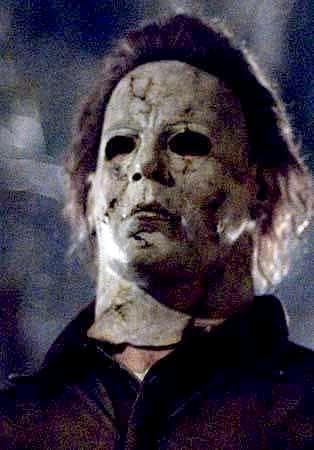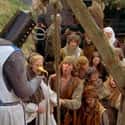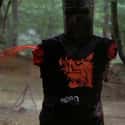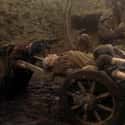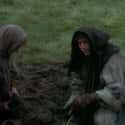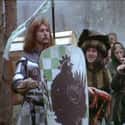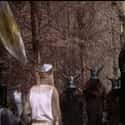-
(#1) Medieval Clergy Needed Very Little Evidence To Convict A Witch
In Holy Grail, we see a young woman accused of witchcraft by an angry mob. The mob is eager to burn the "witch," but Sir Bedevere stops them from going through with it - at least until they can prove she weighs as much as a duck. If her weight is equal to the duck, he claims, then she is probably made of wood and therefore a witch. That's why witches burn, after all.
The questions Bedevere poses to the mob, and his test for determining witchcraft, are utterly absurd to a modern audience, but they do hold a sliver of historical accuracy. Nonconformists, or anyone considered an outsider, were deemed by the medieval Catholic Church to be a public danger. Simply deviating from the norm was sensationalized and criminalized. Clerics preached of the eminent threat these groups presented and insisted that their nonconformity was the work of the devil.
Even women who could not conceive and people born with medical abnormalities were attributed to Satan, as evil resided in both the moral and physical realms. Jews who practiced openly, those accused of homosexual behavior, and, of course, those who were said to practice sorcery were considered offenders deserving of execution. Many accused witches were antagonized until they confessed, then most often hanged or burned.
-
(#2) Knights Were Thuggish And Found Any Reason To Fight
Though the Black Knight’s insistence that his loss of limbs is “just a flesh wound” is silly, his willingness to throw down against King Arthur for no apparent reason is not that far-fetched. While a knight’s stated duty was to protect those beneath him while upholding a code of conduct prescribed by the clergy, this was often not the case.
As nobility did not work, knights grew restless when there were no clashes to be fought. Medieval tournaments were created to provide an outlet for the warlike impulses of aristocrats. These pageants of military prowess channelled a knight’s aggression and desire for glory by displaying their noble lineage, chivalry, and military skills in front of huge crowds.
-
(#3) Medieval Peoples Used Livestock As Biological Siege Weaponry
“Fetchez la vache!” commands the taunting French guard before catapulting a cow toward the Knights of the Round Table. Though it’s played for laughs, the use of biological weaponry did, in fact, occur throughout history.
The first recorded instance of biological weaponry took place during the Carthaginian Wars in the fifth century BC, when the Greco-Romans contaminated their adversaries' food and water sources with rotting animal carcasses. In 190 BC, the Second Macedonian War saw the army of Antiochus III hurl pottery filled with poisonous snakes aboard Roman ships, and plague-riddled cadavers were launched into enemy territory during the Mongol siege of Kaffa in 1347.
-
(#4) Grave Diggers Collected Cadavers En Masse During The Black Plague
When the Bubonic Plague, or Black Death, raged in Europe, it struck down so many people that grave diggers really did go through towns collecting the deceased. The highly contagious plague is estimated to have wiped out one-third to one-half of the European population during the late Middle Ages.
While individual burials were standard prior to the outbreak, most traditional funerary practices were suspended due to the extraordinarily high number of casualties. Mass graves became the only way to keep up, and cadavers were often piled five-deep in long trenches.
Fear of contamination led family members to expel their deceased loved ones from their homes as soon as possible. Men of low social standing, known as the Becchini, were tasked with lugging carts through the streets to collect discarded citizens and lug them away. Sometimes the sick would even be piled onto carts alongside the deceased, as their demise was an inevitability. So there is, in fact, some dark truth to the “I’m not dead yet” bit in the film.
-
(#5) Knights May Have Had Trouble Counting Since They Were Not Educated
Though gifted in the art of war, medieval knights were often uneducated in subjects like mathematics. Until the 12th century, basic arithmetic and geometry were more or less unknown in Western Europe to all but the clergy. Not even basic calculation was taught to most.
King Arthur bumbling his attempt to count in the Holy Hand Grenade scene - uttering, “One, two, five,” before being corrected with someone saying, “Three, Sir!” - is not as absurd as it may seem.
-
(#6) Peasant Life Was Dingy, But They Did Have Plenty Of Free Time
Peasants of medieval times were filthy and constantly endangered by disease, starvation, and the skirmishes of the upper classes. In Holy Grail, peasants are able to identify the king because he doesn’t have “sh*t all over him.”
When peasants worked, it was hard and unforgiving, but they also had two to six months of “vacation time” each year, as well as time off for holidays and all manner of special events. This may explain the peasants of the film engaging in absolutely ridiculous activities to pass the time, such as bludgeoning streams and repeatedly hurling a cat into a wall.
-
(#7) Flagellants Chanted And Punished Themselves So God Would Pity Them
Just as monks march through the village streets and repeatedly smack themselves in the forehead in Holy Grail, flagellants actually did parade through towns chanting and scourging themselves. The practice was inspired by the fears that came with the prominence of the Black Plague.
Flagellants hoped their show of self-harm and devotion would spare them the wrath of God and inspire others to repent. The Brotherhood of the Flagellants originated in Hungary and quickly spread across Europe. England, however, had only one parade of the Brotherhood.
The flagellants marched through towns, with red crosses emblazoned upon their dark garments, their heads hung with eyes shielded by masks or hoods. They sang somber hymns, and each carried a slim flogger with iron on its knotted end. When a signal was given, they whipped themselves and one another.
When the Brotherhood made their procession through London, the Brits were thoroughly unmoved by the display and forced the flagellants out of their country.
-
(#8) Knights Each Had Their Own Unique Heraldry
The signs emblazoned on a knight’s belongings proclaimed their achievements and pedigree, and were unique to each knight. This “coat of arms” was most often displayed on a knight’s shield. Normally, a knight’s heraldry would be ceremoniously bestowed upon them to be displayed as a badge of honor.
The practice dates back to ancient times, when such heraldry indicated people, families, or groups of peoples. The Lion of Judah was an example of ancient Hebrew heraldry, and ancient Romans sported the Eagle of the Caesars. The totems of Native Americans are another example of the practice.
-
(#9) Medieval Clergy Really Emphasized The Number Three
Due to a deeply held, superstitious belief in numerology during Medieval times, the number three was considered incredibly important. It was thought to be holy, as it signified the Holy Trinity. The learned clergy, in particular, took number symbolism very seriously and applied it to everything from scripture to architecture.
On a wider scale, the words “all” and “many” were used instead of the number three. The terms “beginning, middle, and end” were a set of three that encompassed everything. Much “counting” of the time consisted of simply “one, two, many.” No wonder King Arthur bungled the number three in the Holy Hand Grenade scene.
-
(#10) People Would Have Trouble Saying Certain Vowels Due To The Great Vowel Shift
In the film, there's no explanation why the word "Ni" is so terrible for the other characters to hear, but that's typical of the Pythons' absurdist humor. However, the Knights Who Say Ni may be a subtle reference to the Great Vowel Shift that began in the 12th century, which gradually changed the articulation of words with long, stressed vowels. For example, the stressed “ee” sound in “beet” would have been softer and less pronounced before this shift.
No one is entirely certain why this change occurred, but it marks the transition from Middle English to today's Modern English pronunciations. Theoretically, it explains Sir Bedevere’s issue with saying “Ni,” though in this instance the vowel shift technically would not have applied.
-
(#11) The French Hated The Brits
The French did, in fact, hate the Brits, and vice versa. Years of animosity built up between the rival kingdoms eventually led to the Norman Invasion of England in 1066, in which the French sought the British crown.
For the next 900 years, the two countries were almost constantly at odds. Given this fact, the French guard’s immediate dislike of the British king makes more sense. In reality, however, King Arthur would have been just as bitter toward the French as they were to him.
-
(#12) Coconuts Were Not, In Fact, Native To Britain
Though considered a tropical fruit and grown with gusto in Central America, the Caribbean, and Hawaii, coconuts are native to the Pacific Basin and Indian Ocean Basin. They were spread through trade, but as King Arthur is told, they definitely did not grow in England - nor were they ever bandied about by industrious swallows.
Medieval Europeans did not ever refer to them as coconuts, but rather the “Nut of India.”
New Random Displays Display All By Ranking
About This Tool
Monty Python and the Holy Grail is an old British comedy film, the film was released in 1975. The film is based on the legend of King Arthur in the Medieval, telling the story of King Arthur and the Round Table Warriors accepting the will of God to find the legend of the Holy Grail. The exquisite scenes and props that fit the historical description have won unanimous praise from critics and audiences.
The random tool has generated 12 items, including 122 times Monty Python and the Holy Grail that are surprisingly historically accurate. You can find more information about this movie. Welcome to check this interesting collection.
Our data comes from Ranker, If you want to participate in the ranking of items displayed on this page, please click here.









